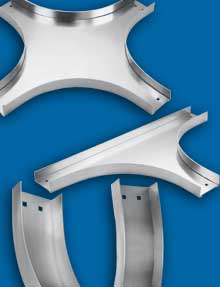Cable Tray Design Guide Pdf
In addition to the standards listed above, CWU has selected several manufacturers of products for telecommunications cabling systems (cable, connectors, termination blocks, patch panels, etc.) and telecommunications distribution hardware (racks, cable tray, enclosures, etc.). The Cable Tray Institute is making available the current edition of this practical guide for the proper installation of aluminum or steel cable tray systems. These guidelines will be useful to engineers, contractors, and maintenance personnel.
How to design cable tray?
Most projects are roughly defined at the start of cable tray design. For projects that are not 100 percent defined before design start, the cost of and time used in coping with continuous changes during the engineering and drafting design phases will be substantially less for cable tray wiring systems than for conduit wiring systems.
A small amount of engineering is required to change the width of a cable tray to gain additional wiring space capacity. Change is a complex problem when conduit banks are involved.
The final drawings for a cable tray wiring system may be completed and sent out for bid or construction more quickly than for a conduit wiring system. Cable trays simplify the wiring system design process and reduces the number of details.
Cable tray wiring systems are well suited for computer aided design drawings. A spread sheet based wiring management program may be used to control the cable fills in the cable tray. While such a system may also be used for controlling conduit fill, large numbers of individual conduits must be monitored. For an equal capacity wiring system, only a few cable tray runs would have to be monitored.
Dedicated cable tray installation zones alert other engineering disciplines to avoid designs that will produce equipment and material installation conflicts in these areas!! As more circuits are added, the cable tray installation zone will increase only a few inches. The space required for the additional conduits needed would be much greater.
The fact that a cable can easily enter and exit cable tray anywhere along its route, allows for some unique opportunities that provide highly flexible designs.
Fewer supports have to be designed and less coordination is required between the design disciplines for the cable tray supports compared to conduit supports.
An 18 inch wide cable tray has an allowable fill area of 21 square inches. It would take 7-3 inch conduits to obtain this allowable fill area (7×2.95 square inches = 20.65 square inches).
The cost of 600 volt insulated multiconductor cables listed for use in cable tray is greater than the cost of 600 volt insulated individual conductors used in conduit. The cost differential depends on the insulation systems, jacket materials and cable construction.
Cable ladder and cable tray systems
The following recommendations are intended to be a practical guide to ensure the safe and proper installation of cable ladder and cable tray systems and channel support and other support systems.

These guidelines are not intended to cover all details or variations in cable ladder and cable tray installation and do not provide for every installation contingency.
It is recommended that the work described in this guide is carried out by competent persons who are familiar with the products being installed and the safety standards associated with them.
Structural characteristics
When considering the installation of the cable supports system it is imperative to avoid the cutting or drilling of structural building members without the approval of the project leader on site.

Support systems can be broken down into a number of elements or components. To design a safe system it is necessary to check each element in turn to ensure:
- That it can safely support the loads being imposed upon it,and
- That the proposed fixings to adjacent components are also sufficient for the intended load
- That any declared deflection limits are note exceeded.
Consult the manufacturer for any further assistance on system design.
Cable Tray Design
On many occasions cable ladder or cable tray is installed in circumstances where it will only ever carry a light cable load, possibly just one or two cables, and its main role is to physically secure and protect its contents.
These programs can include crack, keygen, patch or serial keys. Izofile also provides mobile apps for both iOS and Android systems. Izofile (Izofile.com) is an attractive site that gives users programs in a full version. People can download programs of several categories and platforms. Primo ramdisk 6.3.1 patch. The software has auto bass, vocal range as well as auto color adjustment toolsets allowing dual, 5,1 and 7,1 channel playback and have a great viewing and vocal experience.
In these situations it is often the inherent ruggedness or the aesthetics of the cable ladder or cable tray design which bear most heavily on the specification decision.
Cable Tray Design Guide Pdf Free
However, when a support system is required to be more heavily loaded it is useful to have knowledge of the theoretical aspects of rudimentary structural design in order to ensure that the completed system does fulfil its purpose with the greatest safety and economy.